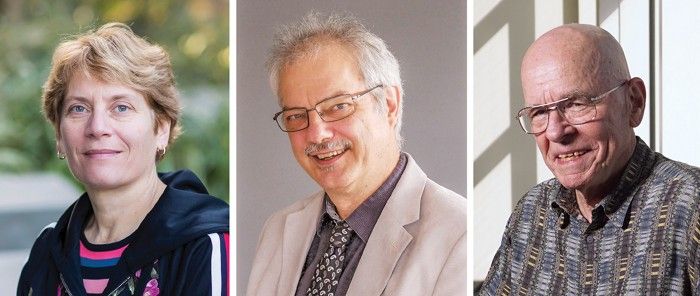On Oct. 5th, 2022, the Royal Swedish Academy of Sciences (RSAS) announced it would be awarding the 2022 Nobel Prize in Chemistry to three individuals “for the development of click chemistry and bioorthogonal chemistry.”
Carolyn R. Bertozzi of Stanford Univ., Morten Meldal from the Univ. of Copenhagen, and K. Barry Sharpless from Scripps Research in La Jolla, California were jointly awarded.
The coining of click chemistry in its original 2001 paper changed the paradigm for the type of reactions chemists sought and used as tools in their work, from many narrowly applicable reactions requiring tightly controlled environments to pulling “Diverse Chemical Function from a Few Good Reactions,” as the title of the paper establishes.
Chemists, of course, still do both. But click chemistry, using a rubric of only the most desirable constraints for practical chemistry, establishes reactions that are highly modular in their application and highly efficient at generating their desired output product with little conflict from competing processes – a chemical multitool. Sharpless and Meldal are associated with this part of the nobel prize.
Bertozzi is responsible for the coining of “bioorthogonality,” an extension on the idea of click chemistry that refines the scope of interest to reactions that can be carried out in a living biological environment, like inside a cell.
The coining of click and bioorthogonal chemistry were both underpinned by the discovery of reactions exemplifying the desired behavior. With practical examples in hand, these two areas of chemistry have seen incredible growth and impact in the last two decades.
“Nobel Prizes honor seminal scientific developments, but also developments that make a practical difference in the world, and this certainly satisfies both of those criteria,” described M.G. Finn, Professor and Chair, School of Chemistry and Biochemistry at Tech. Finn’s laboratory and research deal directly with click and bioorthogonal chemistry. Finn was also co-author on the original click chemistry paper alongside Hartmuth C. Kolb and nobel-laureate Sharpless.
As a renowned chemist with a list of accolades relating to his work in click chemistry, Finn was pinned by many in the chemistry community as a contender for this year’s prize. When asked about his role with the development of click chemistry and whether he agreed with the decision of the Nobel Prize Committee, Finn said “Oh, perfectly appropriate! So, no, Sharpless was the real intellectual leader here, the real inspiration for this.”
“Hartmuth Kolb and I were helpers, but no, this was perfectly appropriate. And, you know, Carolyn Bertozzi [was] certainly … an inspiration [and] a clear intellectual leader at that time, and throughout since, [she] really showed us how to use this chemistry in a biological context,” Finn said. “And, Morten Meldal’s lab co-discovered the [click chemistry] reaction, what I mean by that is [they] discovered [it] at the same time as Sharpless’s laboratory, the reaction that essentially defined click chemistry. Click chemistry goes beyond that reaction now, but it was that reaction that showed the real power of the idea. And so, they’re all worthy recipients, and I think the Nobel committee got it right.”
One of the seminal reactions of click chemistry involves preparing two substances of interest such that one has a chemical group called an azide, and the other has a complementary chemical structure called an alkyne. These two groups are then inclined to “click” together rapidly upon mixing, joining the two original substances.
The Popular Science Background, released by the RSAS in conjunction with their announcement, illustrates some notable applications of click chemistry: “If a manufacturer adds a clickable azide to a plastic or fiber, changing the material at a later stage is straightforward; it is possible to click in substances that conduct electricity, capture sunlight, are antibacterial, protect from ultraviolet radiation or have other desirable properties.”
Finn also emphasized that “the applications of click chemistry range widely, from making new materials that you build stuff with, to making new drugs, to making drugs in the body, where they don’t exist outside of the body, to making molecules that can sense other molecules.”
“Many researchers have also started to develop clickable antibodies that target a range of tumors. Once the antibodies attach to the tumor, a second molecule that clicks to the antibody is injected,” Finn said.
The RSAS Popular Science Background published alongside the announcement saying, “For example, this could be a radioisotope that can be used to track tumors using a PET scanner or that can aim a lethal dose of radiation at the cancer cells.”
Finn even made reference to research that uses, “artificial pieces of DNA that the cell recognizes and copies as though it were natural DNA” — all built through the use of click chemistry.
“The applications are limitless, but they get more and more creative,” said Finn.
He and other chemists in the field see the awarding of the Nobel Prize as shining a positive light on this area of chemistry. Though it has the distinction of already being popularly known by many chemists, biologists and material scientists, a field purporting such wide potential application still sees benefit in increased attention and academic interest.
Finn ended by saying, “The beauty of click chemistry is it allows you to think about why you’re doing something rather than how to do it. … A lot of our problems have molecular solutions, and this is a way to get to those solutions faster sometimes.”
All three laureates continue to work in the field. Bertozzi is a professor at Stanford and the director of Stanford ChEM-H. She runs the Bertozzi Group, which cites work in many related areas of biochemistry. Sharpless is a professor of chemistry at Scripps Research, a nonprofit facility conducting research and education in biomedical science. Meldal is a professor at the University of Copenhagen and head of the Center of Evolutionary Chemical Biology.
